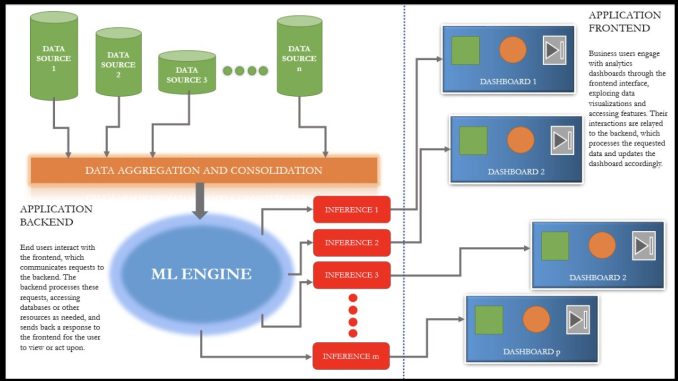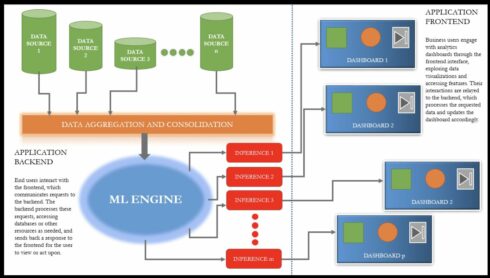


In the evolving realm of project management, AI-driven Decision Support Systems (DSS) offer transformative benefits. These systems integrate diverse data sources, providing comprehensive dashboards that offer project managers a holistic view of performance metrics. Machine learning within DSS facilitates predictive analytics, giving insights into potential challenges and milestones tailored to each project’s nuances.
Key advantages include enhanced decision-making agility through real-time analytics, proactive management through predictive insights, and operational efficiency via task automation. This automation allows managers to focus on strategic initiatives, while the data-driven transparency of DSS fosters stakeholder trust and collaboration. Overall, AI-driven DSS is reshaping project management, driving operational excellence, and ensuring success in today’s data-driven landscape.
Fig 1: Convergence of Machine Learning Backend and Analytics Dashboard Frontend: A Synoptic Representation of Data-driven Decision Support in Contemporary Applications.
From Data Insights to Strategic Decision
In modern project management, converting data into useful insights starts by gathering and verifying data from various sources. Machine Learning (ML) tools then analyze this data to find patterns and anomalies. Regression models, like Linear Regression, are great for estimating project costs and durations. Meanwhile, neural networks offer detailed analyses for more complex situations and risk assessments. Together, these data collection and ML analysis methods form a strong foundation, improving accuracy and providing the strategic vision needed for project success. Let’s delve into some of these techniques in context of a project management software.
Linear Regression is useful for predicting continuous outcomes, such as project costs, based on several factors. On the other hand, Logistic Regression predicts binary outcomes, like project success or failure, using past data. While Linear Regression is seen as simpler, understanding its basic principles and results is crucial. Logistic Regression, while similar, requires a deep understanding of its classifications.
In time series forecasting, ARIMA excels in interpreting time-related data, whether it is tracking project progress or resource use. However, mastering ARIMA’s parameters can be challenging. Decision Trees, which combine classification and regression, identify key project factors. Techniques like Random Forest enhance this precision but can be complex and resource-intensive. Neural Networks, such as RNNs and LSTMs, are ideal for analyzing sequences, making them great for tracking project trends. However, they require a thorough understanding, careful adjustments, and abundant data. Clustering Algorithms, like K-Means, group project elements based on similarities, aiding in resource allocation. Hierarchical Clustering reveals deeper data structures and project relationships. While K-Means is simpler, deciding on the number of clusters can be tricky. Hierarchical Clustering, though insightful, can be resource-intensive with large datasets. For detecting anomalies, tools like Isolation Forest are invaluable, highlighting unexpected project deviations. Isolation Forests strike a commendable balance between efficiency and accuracy, tailored for intricate datasets yet relatively simple to deploy. Additionally, using Natural Language Processing (NLP) for tasks like Text Classification and Sentiment Analysis offers insights into project feedback and stakeholder opinions. The complexity of these NLP tasks varies, from basic analyses like those that can be facilitated by packages like NLTK or spaCy to intricate endeavors, especially when addressing specialized domains.
In summary, the integration of these machine learning techniques into project management software equips managers with a wealth of insights derived from historical data, enabling them to make more informed and strategic decisions. By leveraging the power of advanced analytics and predictive modeling, project leaders can anticipate challenges, optimize resource allocation, and foresee potential bottlenecks. However, the efficacy of these techniques is contingent upon several factors, including the unique characteristics of the project, the quality and granularity of available data, as well as the specific analytical requirements. Hence, selecting the most appropriate ML methods tailored to the project’s distinct context and objectives is paramount for deriving actionable insights and achieving desired outcomes.
DSS capabilities of 20 Project Management Tools
In the modern business environment, Microsoft Project (MSP) rules supreme due to its smooth compatibility with Microsoft tools and advanced analytics via Power BI. Jira by Atlassian is recognized for its agile capabilities and ability to work with multiple plugins, offering adaptability but possibly leading to fragmented setups. Smartsheetmerges the simplicity of spreadsheets with project oversight, presenting visual dashboards; yet, advanced analytics might call for additional BI tool integration. Asana provides straightforward project tracking, but in-depth insights might require supplementary integrations. Trello by Atlassian offers an intuitive Kanban board, with its native analytics often enhanced by Power-Ups or third-party integrations. Basecamp emphasizes communication, offering foundational analytics suitable for modest projects, while larger endeavors might lean towards third-party solutions. Monday.com offers a visually appealing interface with integrated project tracking, although advanced analytics could demand BI integrations. Wrike combines task handling with basic reporting; its adaptability is a highlight, but detailed analytics might need users to explore further integrations. Adobe Workfront addresses enterprise-level demands with comprehensive work management and reporting, potentially being too robust for smaller teams. Clarizen targets repetitive projects with advanced functionalities. It offers advanced project management with customizable analytics. Its focus on custom insights positions it as a potent tool but may pose challenges in terms of complexity. Notion serves as a collaborative platform, merging task management with note-taking. Its versatility is evident, yet comprehensive analytics might require third-party enhancements. ClickUp positions itself as an all-in-one platform with task management, docs, goals, and chat. It can be utilized to streamline project tasks: auto-generate subtasks, condense comments, and autonomously update projects with its AI manager. Its broad feature set is complemented by integrated reporting but might require deeper integrations for advanced analytics. Airtable melds spreadsheet ease with database functionalities; its advanced analytics typically benefit from integrations. Airtable is available on mobile devices and allows for integrations with third-party applications like Slack and Google Drive. Redmine is an open-source tool which offers fundamental project management; for enriched analytics, plugins are needed. Podio provides adaptable work management, facilitating custom workflows. While its analytics are varied, third-party tools can augment its capabilities. Teamwork emphasizes teamwork, merging task and project management, and though its reporting is insightful, deeper analytics might call for more integrations. LiquidPlanner employs predictive planning, showcasing dynamic views with real-time data; however, intricate analytics might still need external tools. Zoho Projects, under the Zoho umbrella, offers holistic project management with in-built reporting; for detailed analytics, other Zoho offerings or integrations might be considered. Targetprocess is for agile management with tailored visualizations; nevertheless, wider analytical demands might drive integration needs. Planview is crafted for enterprise portfolio oversight, providing comprehensive reporting that suits intricate organizational needs.
To sum it up, while these tools offer AI-enhanced features, the scope and sophistication of their Decision Support System capabilities differ. Organizations should evaluate their specific needs, considering built-in features, integrations, or a blend of both to address their Decision Support System requirements effectively. Moreover, this presents a significant chance for these tools to evolve and introduce innovative features and offerings as they transition to the next versions.
Conclusion
In AI research, future decision support systems (DSSs) are expected to employ advanced reinforcement learning models for dynamic decision-making. AI-driven DSSs in project management offer data-driven insights, predictive analytics, and tailored recommendations, elevating decision-making quality. As AI evolves, DSS capabilities will further refine, providing more context-aware solutions for project management challenges. Thus, integrating AI-driven DSSs becomes crucial for achieving operational excellence and sustained project success in today’s complex landscape.

